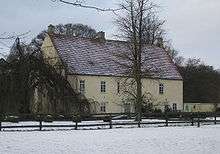Eugen Hemberg
Eugen Peter Alexander Hemberg (1845-1946) was a Swedish forester, author, and hunter.
Education and Career

Hemberg graduated with a degree in forestry from the Swedish Forestry Institute ("Skogsinstitutet") in 1869. Upon graduation he began making long exploration trips to Russia, Finland, Poland, Germany, and the Krkonose mountains, where he documented and explored the local forestry and hunting. Upon Hemberg's return to Sweden in 1874 he began working for the Swedish government in forest management in Kalix and Arljeplog between the years 1874-1878. Towards the end of the 19th century, he returned to Russia to continue documenting it's hunting and forestry practices (1898-1899). The year of his return to Sweden 1899, he was promoted to "The State's Forest Engineer" in Ystad and finally to 'head forester' in Kronoberg's county in 1904-1920.[1][2]
Hemberg published several important books from his travels including: Jakt- och turistskildringar från tsarernas land (1896–97) ('Hunt and tourist depictions of the land of the Tzars'), Jaktbara däggdjurs gångarter och spår (1897–1915) ('Huntable mammals' gaits and tracks'), Från Kola och Ural (1908) ('From Kola and Ural'). Furthermore, he wrote the following historical fiction: Stenåldershorden (1923) ('The Stone-Age Hoard'), and Varjagerna (1924) ('The Wolf Hunters'). Hemberg also published articles in the Russian crown's yearly forestry publication, Forets d'Oural.[1][3]
Hemberg was a passionate hunter, and at age 36 he was made a member of the Swedish Royal Hunting Club, upon a meeting with Oscar I, who spontaneously decided surpass the voting procedures normally required for membership. He was also a guest in the Russian Empire's Hunting Club.[1]
In 1896, August Strindberg visited Ystad, and through Dr Anders Eliasson, Hemberg and Strindberg met and developed a friendship over their mutual interest in nature.[4]
Family
Eugen Hemberg was born on 9 November 1845 in Ystad, and died 14 March 1946 in Växsjö, four months after his 100th birthday. He was the son of the estate owned Fritz Eugen Hemberg and Clara Wilhelmina Åkerblom, and the grandson of Jöns Peter Hemberg. Upon his father's death he inherited Smedstorp Castle.[5]
Hemberg married Agnes Mathilda Lundgren (1856-1902), who was the daughter of the alderman John Robert Lundgren. Together they had the sons, Robert, Jan, and Arnulf. Upon the death of Agnes Mathilda, Hemberg remarried with Elma, and had a daughter, Edit.[1]
Bibliography
- Jakt- och Turistskildringar från Tsarernas land, Stockholm, 1896
- På obanade stigar : jaktskizzer, sagor och noveller från Lappland, Bonnier, Stockholm, 1896
- Skandinaviska däggdjurs trampaulor. Monografisk studie, Stockholm, 1897
- Från Kola och Ural. Vildmarksbilder, Stockholm, 1902
- Stenåldershorden : De första människorna på Sveriges jord. av Eug[en] Hemberg, C. E. Fritze, Stockholm, 1923
- Varjagerna : en skildring från hedenhös, C. E. Fritze, Stockholm, 1924
- En nittioårings minnen : vandringar i kulturens och naturens tempelhallar, Scania, Malmö, 1936
References
- "Eugen P A Hemberg - Svenskt Biografiskt Lexikon". sok.riksarkivet.se. Retrieved 2017-09-09.
- Hildebrand, Albin (1900). Svenskt porträttgalleri, band 15. H.W. Tullberg, Stockholm.
- Svenska skogsvårdsföreningen: Skogen, band 33, Sveriges skogsvårdsförbund, Stockholm, 1946.
- SAXO, null (2009-10-29). "Strindberg på exkursion i Ystad - Ystads Allehanda". Ystads Allehanda (in Swedish). Retrieved 2017-09-10.
- Sveriges dödbok 1901–2013.